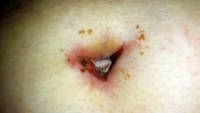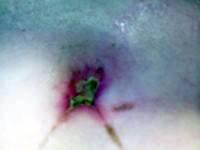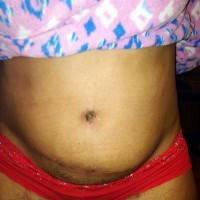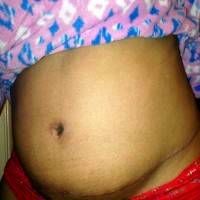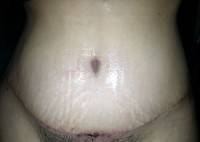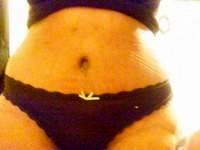Infected belly button after tummy tuck
For the most part, the belly button (umbilicus) heals very well after abdominoplasty. However, occasionally you may have a small area of skin breakdown at the incision or a small infection.
It is important that you see your surgeon to make sure everything is okay. Even if you do have skin breakdown at the belly button, these issues are self-limiting and tend to heal very nicely. (David Shafer, MD)
A full tummy tuck normally begins with an incision from one hip to the other. This incision goes through the skin and fat layer but does not penetrate the muscle layer.
The skin and fat layer together is lifted off of the muscle layer until the bellybutton is reached.
In order to continue lifting the skin and fat layer off of the underlying muscle, an incision is made around the bellybutton, releasing the bellybutton from the skin and fat layer. The skin and fat layer is then elevated off of the muscle layer up to the rib margin.
At this point, the skin and fat have been completely lifted off of the muscle layer and the bellybutton remains in the middle of the surface of the muscle layer. Very often, the patient will benefit with stitches placed in the muscle layer to tighten it up. Once the muscle layer is tightened, the skin is pulled downward as snugly as possible.
The excess skin is removed and a new opening is made over the belly button. The belly button is brought through this opening and stitched into place. The belly button does not change its location. Drainage from the belly button incision could be secondary to irritation caused by stitches placed in the muscle layer to tighten it up.
If this is the case, then it may be necessary to remove the offending suture. If the drainage is secondary to a localized infectious process, then antibiotics and special wound treatment may solve the problem. (John J. Edney, MD, Omaha Plastic Surgeon)
Deep Suture Infection Following Tummy Tuck
Persistent drainage from the area around the belly button following abdominplasty is usually always related to infection around the deep sutures. During this procedure a lower abdominal incision is made and a skin flap elevated to the level of the rib cage.
This requires an incision around the belly button for mobilization of this skin flap. Once this flap has been elevated the underlying muscles are tightened with non- absorbable sutures. In some cases, bacteria is able to pass through the umbilical incision and infect the deep sutures. This results in drainage from the area around the belly button. In most cases treatment requires removal of the infected suture and systemic antibiotics. It’s important that you consult your surgeon so an appropriate treatment plan can be formulated. (Richard J. Bruneteau, MD, Omaha Plastic Surgeon)
Belly button discharge
It would be unusual to have DISCHARGE FROM YOUR infected belly button after tummy tuck. So sorry about the caps. Probably all will be fine without addit intervention. (Christopher J. Davidson, MD, FACS, Wellesley Plastic Surgeon)
Belly button drainage after tummy tuck: Slow healing or suture
As reviewed below, the source of your problem is most likely to be, with about 90% certaintly, either a suture or delayed healing. If it is the former, it may require removal. This is typically a minor procedure. If it is slow healing, it may take some time, usually 3 weeks with wound care. However, this is just my opinion based on frequently performing the procedure. Definitely discuss this with your surgeon and feel confident that it can be managed. In brief, I hope this helps confirm what the others have said, (Otto Joseph Placik, MD, Chicago Plastic Surgeon)
Belly Button drainage can be caused by a buried suture knot
Typically when recreating the umbilicus a buried absorbable suture may be used. Sometimes these become exposed or infected thus causing the drainage. You need an examination to determine the cause. If it is the suture knot then it needs to be removed. Also there could be an area of fat necrosis, which is dead fat, this will also cause some drainage. (Jeffrey Zwiren, MD, Atlanta Plastic Surgeon)
The incision to recreate the belly button during an abdominoplasty is usually a circle to bring your navel back to the surface. If the skin is thick, it can put some tension on the sutures. Occasionally the blood supply can be affected. Either way, even with delayed healing, the navel usually heals very well. Keep the area clean as you are doing.
See your doctor to make sure the blood supply and sutures are okay. If you need a revision, it may not be done until the area is completely healed. Most often this can be done in an office OR and not got to a surgerycenter. (David A. Dreyfuss, MD, Chicago Plastic Surgeon)
This might just be something small or it could be a suture problem. Your surgeon should be seeing you through this to be certain the problem resolves. It might take a few months to sort out. Best Regards, JPD (John P. Di Saia, MD, Orange Plastic Surgeon)
There are a variety of issues that can occur with the umbilicus after a tummy tuck. Your surgeon would want to know you are having a problem so they can evaluate you and prescribe the proper care. Most like likey it will heal on its own but you should go and be seen. (Richard P. Rand, MD, FACS, Seattle Plastic Surgeon)
